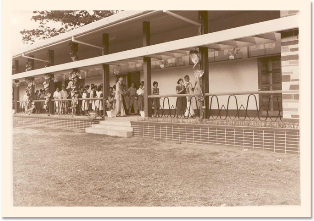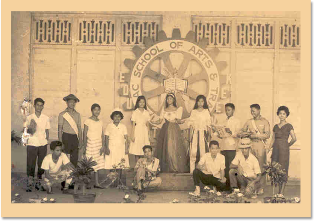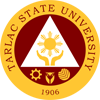Being the premier center of learning in the province of Tarlac, the beginning of the Tarlac State University (TSU) are synchronous with the beginning of public education in this heartland of Central Luzon and the whole Philippines. The early and dominant image of TSU among the people of Tarlac was its being a trade school, and its origin as such could be traced to as early as 1906, when the director of public instruction mandated the offering of intermediate grades and selected areas in the country to cater to industrial and vocational courses.
center of learning in the province of Tarlac, the beginning of the Tarlac State University (TSU) are synchronous with the beginning of public education in this heartland of Central Luzon and the whole Philippines. The early and dominant image of TSU among the people of Tarlac was its being a trade school, and its origin as such could be traced to as early as 1906, when the director of public instruction mandated the offering of intermediate grades and selected areas in the country to cater to industrial and vocational courses.
In 1909, under the auspices of the provincial government and the Provincial High School, this school begun to in secondary students in its fold. By 1921, it had evolved into a full secondary school. In 1931, the trade school was annexed to Tarlac High School during the principal ship of Russel Taylor – a status it maintained until he onset and the end of the Second World War.
In 1946, immediately after the war, Tarlac Trade School was officially separated from the Tarlac High School, with the appointment of Manuel T. Espinosa as its principal. More than a decade later, in 1959, the Congress of the Philippines approved House Bill 1006, jointly sponsored by Congressmen Constancio Castaneda and Jose Roy, converting Tarlac Trade School into Tarlac School of Arts and Trades (TSAT); with Mr. Espinosa also becoming its first Superintendent. As a nationalized academic institution, TSAT began to Offer collegiate technical education courses in the province.
In 1965, through the passage of Republic Act 4337, TSAT acquired its full-fledged status as a college, the Tarlac College of Technology (TCT). Among other provisions, the law called for the merging of TSAT with Tarlac National Agricultural School in Camiling, Tarlac. Dr. Mario Manese was appointed as its first president (1965-1972), who introduced the courses teacher education and engineering.
Prof. Jack Smith replaced Dr. Manese in 1972 as TCT President. It was his early tenure when Presidential Decree 609 was mandated in 1974, which instructed the separation of TCT from its agricultural component, which became the present Tarlac College of Agriculture in Camiling. Smith’s lengthy stay in TCT saw its expansion as a state college, particularly with the acquisition of a 10-hectare lot in Barrios Ungot and Maliwalo that came to be known as Lucinda Campus and which eventually became the site of the Laboratory School and various agro-industrial projects of the institution. This campus, about 7 kilometers from main campus, was donated by the family of Serafin G. David on August 29, 1973 and named after the family matriarch Lucinda David.
In 1976, the TCT organized the Graduate School with academic programs leading to the degrees of Master of Arts in Education, with majors in Guidance in Counseling and Educational Management. In 1978, the TCT set-up degree programs in Master of Public Administration, Bachelor of Science in Business Administration, and the revised two-year Trade Technical Education, and in 1983, the Bachelors of Science in Architecture and Elementary Education.
Dr. Ernesto Cosme was designated Officer-in-Charge in September 1984, eventually becoming TCT’s third and last president. It was during his administration that R.A. 6764was signed into law by then President Corazon C. Aquino on October 13, 1989, converting TCT into Tarlac State University (TSU); thereby serving as its acting president. The conversion was made possible through the sponsorship of Tarlac’s three congressional district congressmen namely, Jose Cojuangco Jr., Jose Yap and Hermie Aquino. Dr. Cosmes’s stay in both the TCT and TSU saw the further expansion of the physical structure and academic programs. Modern buildings rose on the 1.2 hectare Main Campus and the 10 hectare Lucinda Campus. Additional programs were opened, such as Doctor of Education Management in Consortium with the Technological University of the Philippines (TUP), Bachelor in Secondary Education, Bachelor of Science and Accountancy, Business Administration major in Entrepreneurship, Chemistry, and Bachelor of Arts and Social Sciences.
Tarlac School of Arts and Trade
On August 08, 1990, the TSU Board of Regents appointed Dr. Alejandro Fernandez. Then Professor of Political Science and Ninoy Aquino Professor of Development in the University of the Philippines, as the first president of TSU. During this time, TSU was able to acquire its more than eight hectares for a third campus in San Isidro under a 50year lease contract with the provincial government. Upon the end of the term of Dr. Fernandez, Graduate School Dean of Dr. Priscillla Viuya, was appointed as OIC of TSU effective February 28 up to mid-September 1994.

On September 14, 1994, TUP Professor Dr. Rodolfo Baking, was appointed by the BOR as the second president of the University. Like his predecessors, his administrative policies were geared towards the upgrading of academic standard and the offering of curricular programs that will cater to the development needs of the government and the private sector. Unfortunately Dr. Baking was not able to finish his term.
On December 5, 1996, the Board designated Academic Affairs vice president Dr. Dolores G. Matias as OIC. A OIC, she steered the University into attaining its visions and missions of offering relevant quality education to the people of Tarlac and its neighboring provinces. During her incumbency, the Graduate School and College of Business and Accountancy attained level two accreditation while the Colleges of Arts and Sciences and Education attained level one accreditation. The College of Engineering, which already had a level one accreditation, was proposed for the next level accreditation. The Colleges of Technology and Architecture were readied to undergo the same process. During this time, passing average in the board examination of the graduates improved. Other courses were opened like B.S. in Computer Science, Bachelor of Fine Arts, and Doctor of public Administration. The Ed. D. major in I.E.M. was continued to be offered by the University on its own, now without the consortium, while another major, educational management, was added to the Ed. D. program. The Testing Center was institutionalized and evening classes were organized. Additional classrooms and university facilities were also built and the students were accorded a function room and added space for their use. The student population during this time increased to more than 10,000.

